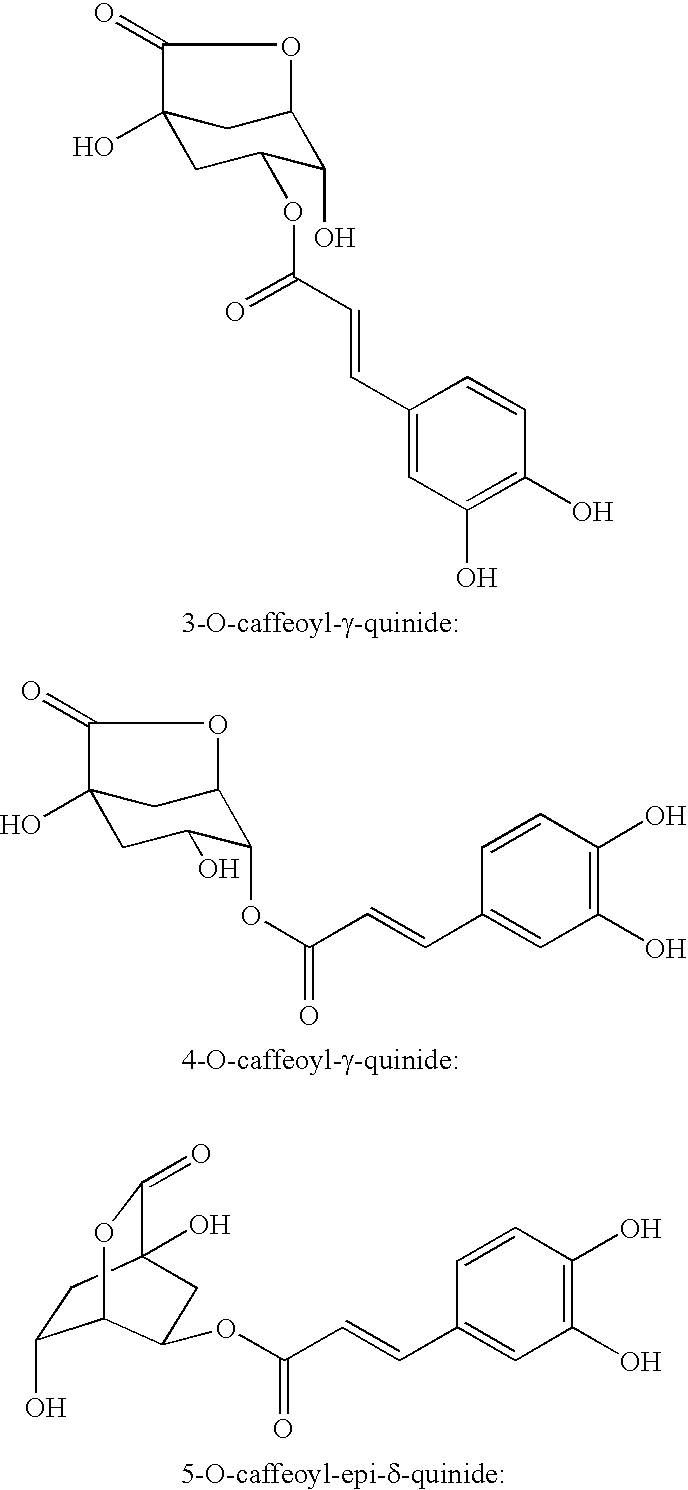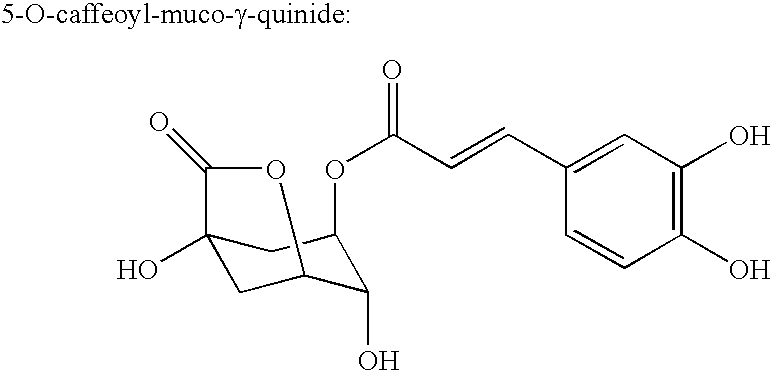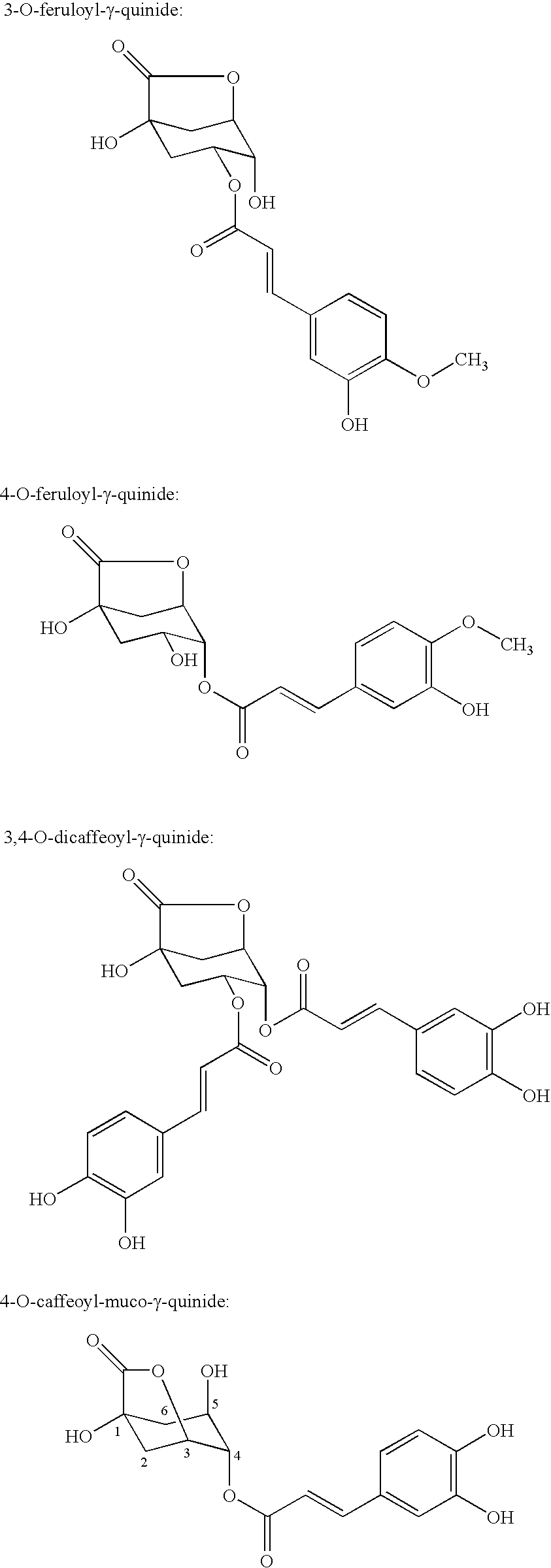Processes for isolating bitter quinides for use in food and beverage products
a technology of bitter quinide and isolating process, which is applied in the field of isolating bitter quinide for use in food and beverage products, can solve the problems of weak flavor of beverages, less desirable flavor attributes, and weak flavor of beverages by consumers, and achieve the effect of enhancing the flavor of beverages
- Summary
- Abstract
- Description
- Claims
- Application Information
AI Technical Summary
Benefits of technology
Problems solved by technology
Method used
Image
Examples
example 1
[0060] About 500 grams of polyamide (SC-6, Machery & Nagel, Easton, Pa.) is suspended in about 1500 mL of water and allowed to swell for about 2 hours at about room temperature. Fines floating on the surface are removed and the slurry is filled into a XK 50 / 100 column (100 cm×5.0 cm; Amersham Pharmacia, Piscataway, N.J.) until a column bed height of about 90 cm is obtained. Using Tefzel® tubing (Amersham Pharmacia, Piscataway, N.J.) and Masterflex® silicone tubing (size 16; Cole Palmer, Chicago, Ill.) the column is connected to a peristaltic pump (Baker Technical Industries.) To remove any impurities, the column is flushed with 200 proof ethanol (Aaper, Shelbyville, Ky.) for 8 hours at a flow rate of about 14.73 mL / min. Subsequently, the mobile phase is switched to water and the column continues to be flushed for approximately 12 additional hours.
[0061] About six liters of coffee brew is prepared in batches containing about 50 g roast & ground coffee (Folgers® Gourmet Supreme decaf...
example 2
[0062] About 1 gram of chlorogenic acid (Aldrich, Milwaukee, Wis.) and about 2 mL of water (Milli-Q®) are mixed and subsequently dried at about 70° C. The residues are then dry-heated for about 18 minutes at from about 220-230° C. The resulting reaction products are dissolved in hot water (Milli-Q®, 100 mL) and after cooling to about room temperature, are extracted with ethyl acetate (5×25 mL, Aldrich, Milwaukee, Wis.). The combined organic layers are freed from solvent and the residues are taken up in ethanol / water (30 / 70, v / v; 10 mL) for further processing.
[0063] In case residual chlorogenic acid needs to be removed, polyamide (MN-SC-6, Machery & Nagel, Easton, Pa.) is suspended in water and filled in a glass column (300×30 mm) up to about 160 mm. The polyamide is conditioned with a mixture of about 250 mL of ethanol and about 250 mL of water and the residues dissolved in water (Milli-Q) are applied to the column. The column is washed with about 750 mL of water and the bitter qui...
example 3
[0064] About 0.250-0.5 mL of the ethanolic bitter quinide isolate of Example 1 (the equivalent to about 25-50 mg dry weight) is dried under a stream of nitrogen and subsequently dissolved in about 100 mL instant coffee beverage prepared from about 1.5 g of Folgers® instant coffee and about 100 mL water. When compared to an instant coffee beverage without the added bitter quinide isolate, the instant coffee beverage having the added bitter quinide isolate has an enhanced, freshly brewed coffee flavor combined with increased body and strength while the hydrolyzed off-note, which is typical for instant coffee, is decreased. Overall, the instant coffee beverage supplemented with the bitter quinide isolate is perceived to be much closer in taste to a freshly brewed coffee.
PUM
 Login to View More
Login to View More Abstract
Description
Claims
Application Information
 Login to View More
Login to View More - R&D
- Intellectual Property
- Life Sciences
- Materials
- Tech Scout
- Unparalleled Data Quality
- Higher Quality Content
- 60% Fewer Hallucinations
Browse by: Latest US Patents, China's latest patents, Technical Efficacy Thesaurus, Application Domain, Technology Topic, Popular Technical Reports.
© 2025 PatSnap. All rights reserved.Legal|Privacy policy|Modern Slavery Act Transparency Statement|Sitemap|About US| Contact US: help@patsnap.com



